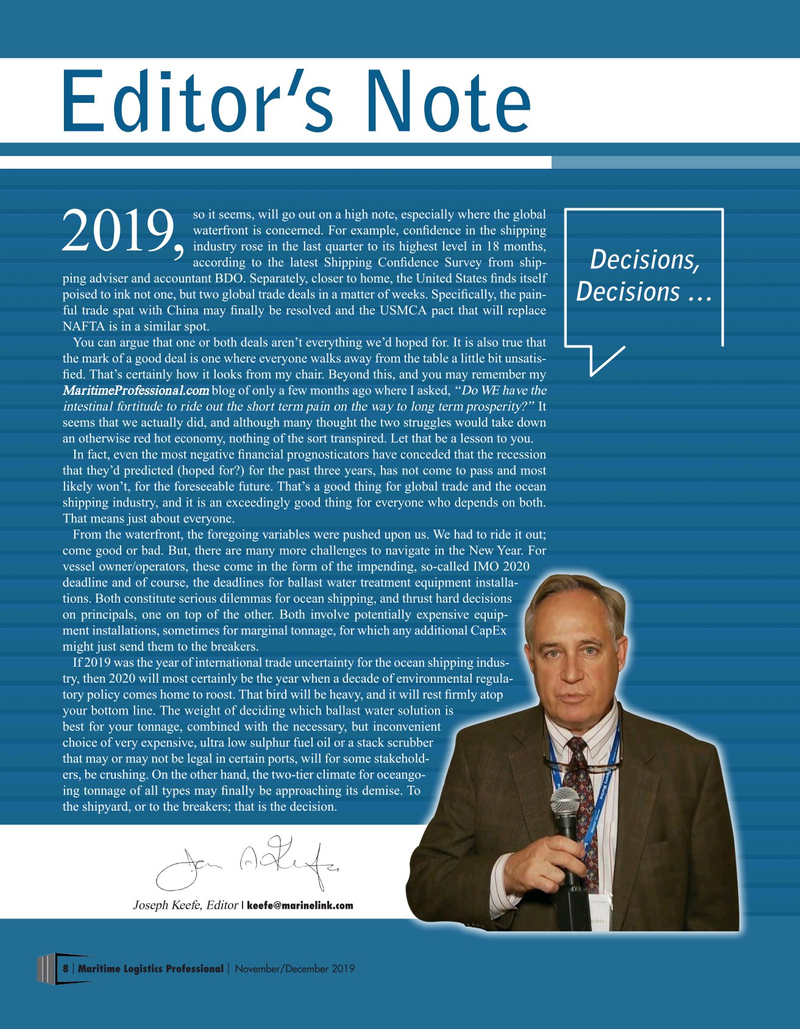
Page 8: of Maritime Logistics Professional Magazine (Nov/Dec 2019)
Short Sea Shipping Ports
Read this page in Pdf, Flash or Html5 edition of Nov/Dec 2019 Maritime Logistics Professional Magazine
Editor’s Note so it seems, will go out on a high note, especially where the global waterfront is concerned. For example, confdence in the shipping 2019, industry rose in the last quarter to its highest level in 18 months, according to the latest Shipping Confdence Survey from ship-
Decisions, ping adviser and accountant BDO. Separately, closer to home, the United States fnds itself poised to ink not one, but two global trade deals in a matter of weeks. Specifcally, the pain-
Decisions … ful trade spat with China may fnally be resolved and the USMCA pact that will replace
NAFTA is in a similar spot.
You can argue that one or both deals aren’t everything we’d hoped for. It is also true that the mark of a good deal is one where everyone walks away from the table a little bit unsatis- fed. That’s certainly how it looks from my chair. Beyond this, and you may remember my
MaritimeProfessional.com blog of only a few months ago where I asked, “Do WE have the intestinal fortitude to ride out the short term pain on the way to long term prosperity?” It seems that we actually did, and although many thought the two struggles would take down an otherwise red hot economy, nothing of the sort transpired. Let that be a lesson to you.
In fact, even the most negative fnancial prognosticators have conceded that the recession that they’d predicted (hoped for?) for the past three years, has not come to pass and most likely won’t, for the foreseeable future. That’s a good thing for global trade and the ocean shipping industry, and it is an exceedingly good thing for everyone who depends on both.
That means just about everyone.
From the waterfront, the foregoing variables were pushed upon us. We had to ride it out; come good or bad. But, there are many more challenges to navigate in the New Year. For vessel owner/operators, these come in the form of the impending, so-called IMO 2020 deadline and of course, the deadlines for ballast water treatment equipment installa- tions. Both constitute serious dilemmas for ocean shipping, and thrust hard decisions on principals, one on top of the other. Both involve potentially expensive equip- ment installations, sometimes for marginal tonnage, for which any additional CapEx might just send them to the breakers.
If 2019 was the year of international trade uncertainty for the ocean shipping indus- try, then 2020 will most certainly be the year when a decade of environmental regula- tory policy comes home to roost. That bird will be heavy, and it will rest frmly atop your bottom line. The weight of deciding which ballast water solution is best for your tonnage, combined with the necessary, but inconvenient choice of very expensive, ultra low sulphur fuel oil or a stack scrubber that may or may not be legal in certain ports, will for some stakehold- ers, be crushing. On the other hand, the two-tier climate for oceango- ing tonnage of all types may fnally be approaching its demise. To the shipyard, or to the breakers; that is the decision.
Joseph Keefe, Editor | [email protected] 8 Maritime Logistics Professional November/December 2019 | |

 7
7

 9
9
